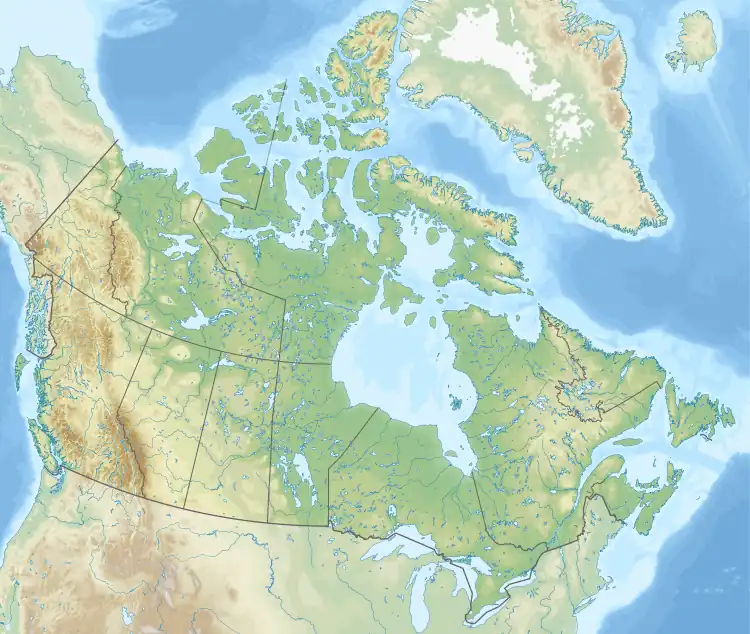| Ipsoot Mountain | |
|---|---|
 South aspect, viewed from Whistler Mountain | |
| Highest point | |
| Elevation | 2,576 m (8,451 ft)[1][2] |
| Prominence | 958 m (3,143 ft)[1] |
| Parent peak | Overseer Mountain (2,749 m)[2] |
| Isolation | 17.2 km (10.7 mi)[2] |
| Listing | Mountains of British Columbia |
| Coordinates | 50°19′32″N 122°59′30″W / 50.32556°N 122.99167°W[3] |
| Geography | |
 Ipsoot Mountain Location in British Columbia  Ipsoot Mountain Ipsoot Mountain (Canada) | |
| Location | British Columbia, Canada |
| District | Lillooet Land District |
| Parent range | Coast Mountains |
| Topo map | NTS 92J7 Pemberton |
| Climbing | |
| First ascent | L. Harrison, J. Booth, R. Pilkington, T. Fallowfield, W. Cadillac, A. Dellow[4] |
Ipsoot Mountain is a 2,576-metre (8,451-foot) glaciated summit located in southwest British Columbia, Canada.
Description
Ipsoot Mountain is situated in the Coast Mountains, 13 km (8 mi) west of Pemberton and 22 km (14 mi) north of Whistler. Precipitation runoff and glacial meltwater from this large mountain drains into Pemberton, Miller and Rutherford creeks, then eventually Lillooet River. Ipsoot is more notable for its steep rise above local terrain than for its absolute elevation as topographic relief is significant with the summit rising over 1,800 meters (5,900 ft) above Rutherford Creek in approximately 4 km (2.5 mi). The mountain was named by the first ascent party, and "ipsoot" means "hidden", or "to hide" in Chinook Jargon, as this peak is indeed hidden from view in adjacent valleys.[5][6] The toponym was officially adopted June 22, 1967, by the Geographical Names Board of Canada.[3]

Climate
Based on the Köppen climate classification, Ipsoot Mountain is located in the marine west coast climate zone of western North America.[7] Most weather fronts originate in the Pacific Ocean, and travel east toward the Coast Mountains where they are forced upward by the range (Orographic lift), causing them to drop their moisture in the form of rain or snowfall. As a result, the Coast Mountains experience high precipitation, especially during the winter months in the form of snowfall. Winter temperatures can drop below −20 °C with wind chill factors below −30 °C. This climate supports the Ipsoot Glacier (also known as the Ipsoot Icefield) on the peak's northwest slope.[8] The months July through September offer the most favorable weather for climbing Ipsoot Mountain.
See also
References
- 1 2 "Ipsoot Mountain, British Columbia". Peakbagger.com. Retrieved 2023-01-14.
- 1 2 3 "Ipsoot Mountain, Peakvisor.com". Retrieved 2023-01-14.
- 1 2 "Ipsoot Mountain". Geographical Names Data Base. Natural Resources Canada. Retrieved 2023-01-14.
- ↑ Dick Culbert (1969), A Climber's Guide to the Coastal Ranges of British Columbia, Alpine Club of Canada, p. 118
- ↑ "Ipsoot Mountain". BC Geographical Names.
- ↑ Laura Belle Downey-Bartlett (1924), Dictionary of the Intertribal Indian Language, Commonly Called Chinook, Smith-Digby Company, p. 15
- ↑ Peel, M. C.; Finlayson, B. L.; McMahon, T. A. (2007). "Updated world map of the Köppen−Geiger climate classification". Hydrol. Earth Syst. Sci. 11 (5): 1633. Bibcode:2007HESS...11.1633P. doi:10.5194/hess-11-1633-2007. ISSN 1027-5606.
- ↑ "Ipsoot Glacier". BC Geographical Names.
External links
- Weather: Ipsoot Mountain